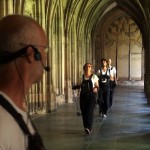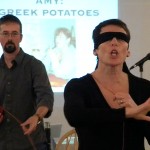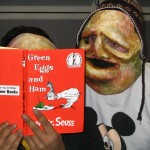- Utrecht, 2011
- Green Space
- Social Potluck
 I am an Associate Professor at the University of British Columbia- Okanagan. I studied at the Lecoq Theatre School in Paris, and have my MFA in film directing from the University of British Columbia- Vancouver. I have a Bachelor of Arts in Drama (Distinction), and a Bachelor of Education in Drama and English from the University of Alberta. I have worked as a performer/creator for theatres in Canada and the U.S. committed to devised work and have written, directed and produced narrative and documentary independent film and lifestyle series television (for which I won a Leo Award in 2001 for Best Director in a Lifestyle Series). My research in eco-art examines indoor and outdoor public spaces as performance venues for live and media art that is designed to be interventionist in nature.
I am an Associate Professor at the University of British Columbia- Okanagan. I studied at the Lecoq Theatre School in Paris, and have my MFA in film directing from the University of British Columbia- Vancouver. I have a Bachelor of Arts in Drama (Distinction), and a Bachelor of Education in Drama and English from the University of Alberta. I have worked as a performer/creator for theatres in Canada and the U.S. committed to devised work and have written, directed and produced narrative and documentary independent film and lifestyle series television (for which I won a Leo Award in 2001 for Best Director in a Lifestyle Series). My research in eco-art examines indoor and outdoor public spaces as performance venues for live and media art that is designed to be interventionist in nature.
- Orange You Glad I Didn’t Say Banana
- Confessions of a Student Body
- Hand Held Devices
In 2007 I moved to the Okanagan valley (Okanagan or Syilix traditional territory) in the interior of British Columbia, Canada, to help establish an interdisciplinary performance program at the University of British Columbia. The Okanagan valley is a fragile dryland region undergoing radical urban and agricultural development. It is a landscape of lakes, sagebrush, saskatoon berries, and suburbias crowding out ponderosa pines. I moved to the Okanagan from the coast. As a body-based performance artist concerned with ecological issues, I also consider the body itself as a kind of geographical terrain. For me, ecological art situates itself at the intersection of human activity (the sensory body) and the environment within which that activity takes place. I position the sensory body more specifically as the site of ecological practice and belonging. For, like David Abram, I have come to believe that the environmental ethic to which we aspire
“will come into existence not primarily through the logical elucidation of new philosophical principles and legislative strictures, but through a renewed attentiveness to this perceptual dimension that underlies all our logics, through a rejuvenation of our carnal, sensorial empathy with the living land that sustains us” (Abram, 29).
My practice and my teaching incorporates various modes of expression: my camera, my body, and dialogical projects that explore sociopolitical relationships. When I look back on the various works contained within these seemingly disparate forms, I recognize that in some way they all examine the theme of belonging. It seems that all I have ever been doing as an artist is exploring how to belong. My recent work in Eco Art has brought this theme to the forefront for it seems to me that if my home (and my art) can be conceived of and developed as inextricably linked to place from an aesthetic and eco-systemic point of view, perhaps the displacement and aching for belonging that I feel will be quieted. Perhaps the same might be true for my audience/students/community and perhaps this artistic practice can help to stimulate a more sustainable (and meaningful) way of life.
- Abram, David. The Spell of the Sensuous. New York: Vintage Books, 1996.







